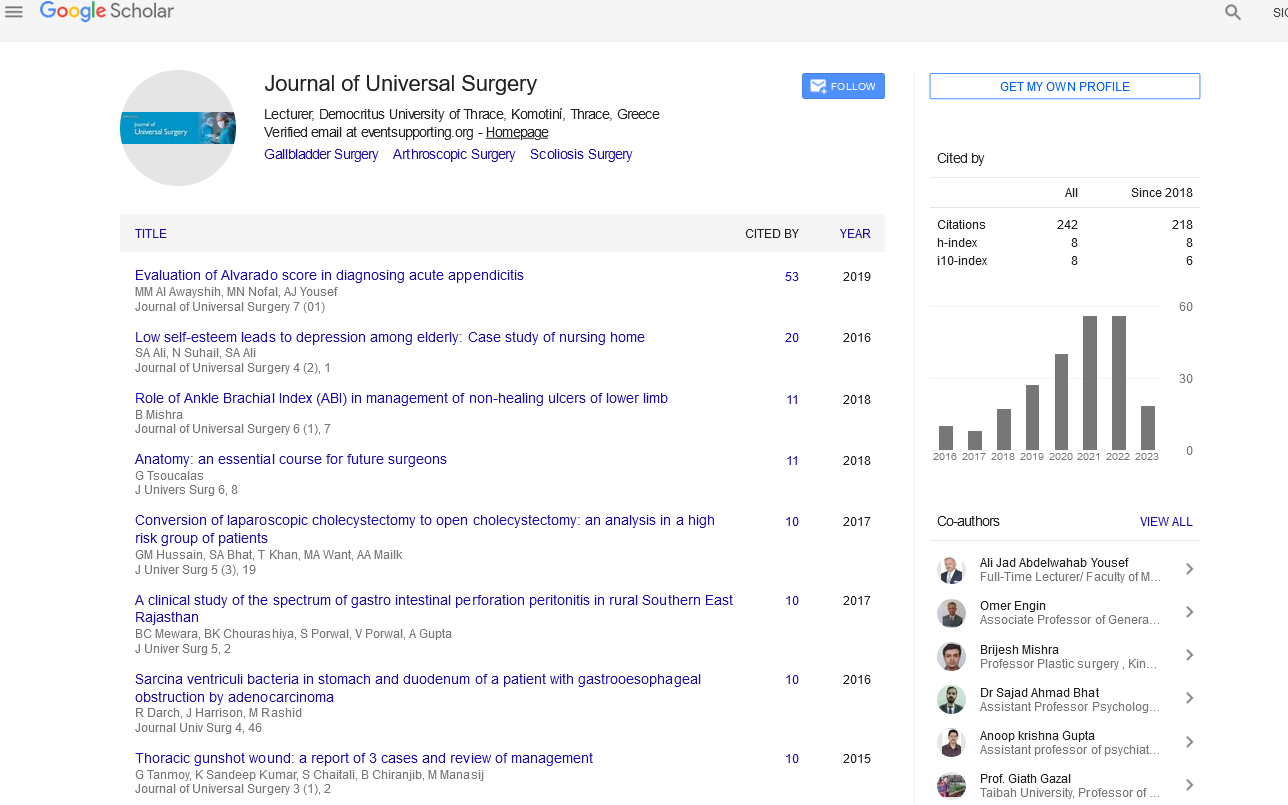Perspective - (2024) Volume 12, Issue 6
Medical Barriers to Glaucoma Surgery: Challenges and Solutions
Nicholas Sadler*
Department of Opthmology, University of Valdez, Valdez, United States
*Correspondence:
Nicholas Sadler, Department of Opthmology, University of Valdez, Valdez,
United States,
Email:
Received: 26-Nov-2024, Manuscript No. IPJUS-24-15366;
Editor assigned: 29-Nov-2024, Pre QC No. IPJUS-24-15366 (PQ);
Reviewed: 13-Dec-2024, QC No. IPJUS-24-15366;
Revised: 21-Dec-2024, Manuscript No. IPJUS-24-15366 (R);
Published:
29-Dec-2024
Introduction
Glaucoma, a leading cause of irreversible blindness worldwide,
often necessitates surgical intervention when medications and
laser treatments fail to control Intraocular Pressure (IOP).
Despite advancements in surgical techniques, several medical
barriers hinder the effective implementation and outcomes of
glaucoma surgery. This article explores these challenges in detail,
emphasizing their implications on patient care and offering
potential solutions.
Description
Delayed diagnosis and disease progression
Glaucoma is often called the "silent thief of sight" due to its
asymptomatic progression in early stages. Many patients are
diagnosed only after significant vision loss, which complicates
surgical outcomes. Advanced disease stages limit the
effectiveness of surgery as damage to the optic nerve is
irreversible.
Solution: Public health initiatives focusing on routine eye
examinations, particularly for high-risk groups, can facilitate
earlier detection. Community-based screening programs and
mobile diagnostic units in underserved areas are crucial for
identifying patients at an earlier stage.
Patient comorbidities
Many glaucoma patients, especially the elderly, have
comorbid conditions such as diabetes, hypertension or
cardiovascular diseases that complicate surgical planning and
execution. For instance, diabetic retinopathy can exacerbate
postoperative inflammation and systemic hypertension can
increase the risk of surgical complications like suprachoroidal
hemorrhage.
Solution: Preoperative management should involve a
multidisciplinary team to stabilize systemic conditions.
Coordination between ophthalmologists and primary care
physicians ensures better surgical preparedness and
postoperative recovery.
Surgical risks and complications
Even with advanced surgical techniques, glaucoma surgeries
such as trabeculectomy or glaucoma drainage devices carry
inherent risks. Complications such as infection, bleb failure,
scarring and hypotony can result in poor surgical outcomes or
even worsen vision loss.
Solution: Recent advancements in Minimally Invasive
Glaucoma Surgery (MIGS) offer a safer alternative with fewer
complications. However, MIGS is not suitable for all glaucoma
types, necessitating a tailored approach for each patient.
Limited access to specialized care
Access to glaucoma specialists and surgical facilities is a
significant barrier, particularly in low-income and rural areas.
The shortage of trained ophthalmic surgeons and the lack of
specialized equipment hinder timely surgical interventions.
Solution: Investments in healthcare infrastructure and the
training of general ophthalmologists in glaucoma management
can address this gap. Telemedicine and remote consultations can
also help bridge the accessibility divide.
Economic constraints
Glaucoma surgeries, especially advanced procedures, can be
prohibitively expensive for many patients. The costs associated
with preoperative diagnostics, surgical fees, postoperative care
and medications pose a substantial burden, particularly in
countries without robust health insurance systems.
Solution: Government subsidies, non-profit healthcare
initiatives, and insurance schemes can make glaucoma surgery
more affordable. Outreach programs providing free or
subsidized surgeries in underserved regions can help mitigate
financial barriers.
Medication non-adherence before and a ter surgery
Non-adherence to prescribed medications is a prevalent issue in
glaucoma management. Patients often fail to follow
preoperative regimens that optimize surgical outcomes.
Similarly, postoperative medication non-compliance can lead to
complications such as infection or poor wound healing.
Solution: Patient education is crucial to improving adherence.
Simplifying medication regimens, using fixed-dose combinations
and involving caregivers in the process can enhance compliance.
Regular follow-up and reminders can also reduce the risk of nonadherence.
Cultural and psychological barriers
Cultural beliefs and psychological factors often deter patients
from seeking surgical interventions. Fear of blindness, distrust in
medical procedures or reliance on traditional remedies can
delay or prevent surgery.
Solution: Culturally sensitive health education programs
addressing myths and misconceptions about glaucoma surgery
can help build trust and encourage timely interventions.
Psychological counseling and peer support groups can also
alleviate anxiety related to surgery.
Postoperative care challenges
Effective postoperative care is vital for the success of
glaucoma surgery. However, factors such as inadequate patient
follow-up, lack of access to healthcare facilities and poor wound
care practices can lead to suboptimal outcomes.
Solution: Providing clear postoperative care instructions and
scheduling regular follow-ups are essential. Mobile health units
and teleconsultations can support patients in remote areas.
Training local healthcare workers to manage basic postoperative
needs can also be beneficial.
Conclusion
Medical barriers to glaucoma surgery are multifaceted,
ranging from delayed diagnosis and patient comorbidities to
economic and cultural challenges. Addressing these barriers
requires a holistic approach involving advancements in
technology, patient education, improved access to care and
multidisciplinary collaboration. By overcoming these obstacles,
healthcare systems can ensure timely and effective surgical
interventions, ultimately preserving vision and improving the
quality of life for glaucoma patients.
Through concerted efforts, the global community can make
significant strides in breaking down the barriers to glaucoma
surgery, paving the way for a brighter and clearer future for
millions at risk of blindness.
Citation: Sadler N (2024) Medical Barriers to Glaucoma Surgery: Challenges and Solutions. J Univ Surg Vol.12 No.6: 058.





